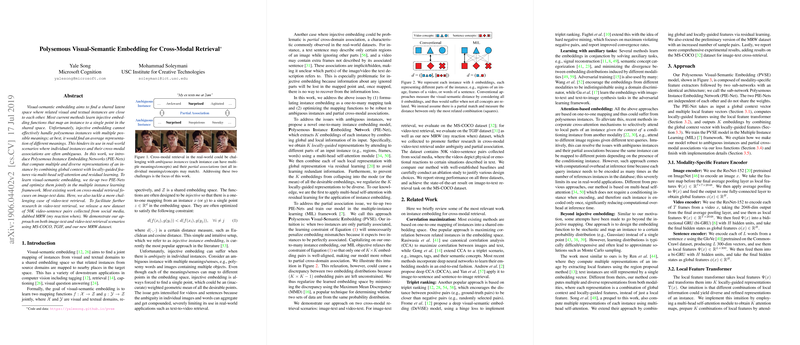Polysemous Visual-Semantic Embedding for Cross-Modal Retrieval: An Analytical Overview
This paper introduces Polysemous Visual-Semantic Embedding Networks (PIE-Nets), aimed at addressing challenges in cross-modal retrieval due to polysemy and partial cross-domain associations in data. The traditional method of mapping instances to a single point in a visual-semantic embedding space often fails when dealing with ambiguity, as seen in real-world data. By contrast, the authors propose a one-to-many mapping through PIE-Nets, facilitating diverse representations of visual and textual data.
The core innovation of this paper is the formulation of the PIE-Nets, which employ multi-head self-attention and residual learning to generate multiple embeddings per instance. By integrating both global and locally-guided features, PIE-Nets provide a richer, context-sensitive representation of instances. This contrasts with injective embeddings, which compress these complex representations into a single point, often overlooking subtle, yet critical, nuances inherent in polysemous data.
The linkage of two PIE-Nets, one dedicated to each modality, enables the simultaneous optimization of visual-semantic embeddings using a multiple instance learning (MIL) framework. This integration maximizes the usage of diverse instance representations, allowing for more robust retrieval, particularly in the presence of partial associations where not every aspect of the pair is directly linked.
The paper showcases its approach using the MS-COCO dataset for image-text retrieval tasks and introduces a new dataset named MRW for exploring video-text retrieval. The MRW dataset, consisting of 50,000 video-sentence pairs curated from social media, provides a fertile ground for testing the efficacy of the PIE-Nets in handling ambiguity and partial associations endemic to real-world scenarios. Through extensive experiments, the paper highlights the superior retrieval capabilities of the proposed architecture over established baselines, notably achieving impressive results in image-to-text tasks.
Empirically, the research asserts significant improvement through quantitative measures such as the Recall@ and median rank metrics across MS-COCO, TGIF, and MRW datasets. These findings reinforce the adaptable nature of PIE-Nets and suggest broader applicability to various cross-modal retrieval tasks beyond initially presented datasets.
Additionally, the paper's comparative analysis with conventional methods such as DeViSE and VSE++ illustrates a marked improvement not only in retrieval accuracy but also in handling instances with weak or implicit concept associations. This positions PIE-Net as a potentially valuable tool for applications needing nuanced interpretability of multimedia content, augmenting tasks like automated video captioning and image tagging with enhanced precision and context-awareness.
The theoretical implications of this work suggest a reevaluation of the current paradigms in cross-modal retrieval. By demonstrating the utility of polysemous embeddings within a MIL framework, it questions the long-standing reliance on one-to-one mappings in visual-semantic tasks.
Looking forward, there are several intriguing research directions prompted by this paper. The extension of multi-head self-attention mechanisms to diverse representations opens the door to advancing neural architectures that better mimic human-like understanding of polysemous language and visuals. Furthermore, the introduction and further development of datasets such as MRW will likely fuel more tailored approaches to cross-modal retrieval challenges, emphasizing the need for addressing both explicit and implicit associations.
Overall, this paper makes a substantial contribution to the field of visual-semantic embedding by proposing a novel framework to tackle ambiguity in cross-modal retrieval tasks, yielding practical approaches and sparking further research opportunities in the field of artificial intelligence.
